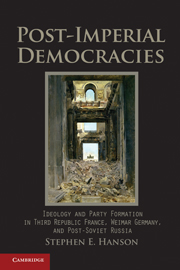 Post-Imperial Democracies
Post-Imperial Democracies Preface
Published online by Cambridge University Press: 05 June 2012
Summary
As the first decade of the twenty-first century came to a close, Russia's political party system was in a parlous state. Despite repeated proclamations by top Russian leaders that building strong parties was crucial for the stability of the state and the future of Russian democracy, party organizations no longer played any independent role in Russian political decision making by the end of Putin's second term as president. The one political party with a mass membership, United Russia, clearly owed its power to the direct financial and institutional backing of the Kremlin and used its overwhelming dominance of both the central and most regional legislatures to slavishly support any and all Kremlin initiatives. Russia's erstwhile liberal parties, Yabloko and the Union of Rightist Forces, had dwindled into splinter groups of no significance. The Communist Party of the Russian Federation led by Gennadii Ziuganov, which had come close to seizing power in the turbulent 1990s, continued to voice opposition to the Putin-Medvedev regime and to sponsor occasional protests but, with public support in the low teens and only 57 seats in the 450-seat State Duma, was essentially impotent. The Liberal Democratic Party of Russia, led by theatrical nationalist Vladimir Zhirinovskii, continued to combine radical rhetoric with faithful support of the Kremlin in all key parliamentary votes. And the rest of the Russian party system was made up of various “parties of power” designed to serve the temporary interests of one or another faction within Russia's ruling circles.
- Type
- Chapter
- Information
- Post-Imperial DemocraciesIdeology and Party Formation in Third Republic France, Weimar Germany, and Post-Soviet Russia, pp. xiii - xxviPublisher: Cambridge University PressPrint publication year: 2010
